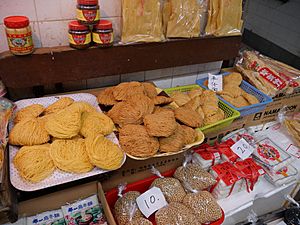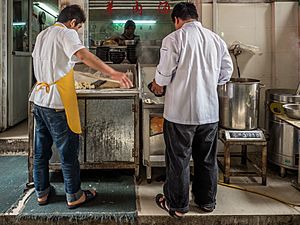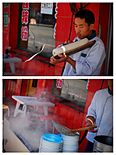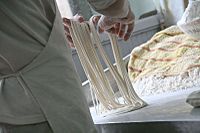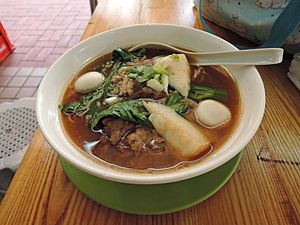Chinese noodles facts for kids

Chinese noodles at a noodle shop in Tuen Mun, Hong Kong
|
|
| Type | Noodles |
|---|---|
| Place of origin | China |
Chinese noodles are a super important and tasty food from China. They come in many different shapes, sizes, and are made from various ingredients. Noodles were actually invented in China a very long time ago. They are a main part of many meals across China and in other countries where Chinese people live.
You can make Chinese noodles from lots of things like wheat, rice, buckwheat, millet, oats, beans, potatoes, and even fish! There are over 1,200 kinds of noodles eaten in China today. Chinese noodles have also become popular in nearby countries like Korea, Japan, Vietnam, Cambodia, and Thailand.
Contents
What are Chinese Noodles Called?
Learning the names of Chinese noodles can be a bit tricky. This is because there are so many types and different Chinese languages (called dialects) use different names.
In Mandarin Chinese, the word for noodles made from wheat flour is miàn (pronounced "mee-an"). If noodles are made from other starches, like rice flour or mung bean starch, they are often called fěn (pronounced "fun").
But wait, it gets a bit more interesting! In places like Hong Kong, people speak Cantonese. So, wheat noodles might be called "mein" there. In other places like Malaysia or Singapore, people might speak Hokkien, and they call wheat noodles "mee." So, the name can change depending on where you are!
The History of Chinese Noodles
Noodles have a very long history in China! The first time noodles were written about was during the Han dynasty (around 25–220 CE). This means people were eating noodles almost 2,000 years ago!
During the Han dynasty, noodles, often made from wheat, became a very important food. The government even found ways to make noodles that were easier to store and transport for the military. These early noodles were made from buckwheat, millet, and pea flours.
Later, during the Song dynasty (960–1279), noodle shops became super popular in cities. Some even stayed open all night! Back then, Chinese wheat noodles were sometimes called "soup cake." This was because many foods made from dough were generally called "bing," and their cooking method made them different.
How Chinese Noodles are Made
Chinese noodles are usually made from wheat flour, rice flour, or mung bean starch. Wheat noodles are more common in northern China, while rice noodles are popular in southern China. Sometimes, ingredients like egg or lye (a special kind of salt) are added to wheat noodles. This can change their color or make them chewier.
Making Chinese noodles usually involves a few steps:
- First, you mix flour, salt, and water to make a dough.
- Then, you shape the dough into bars and let it rest.
- Next, you pull or cut the dough into long strips.
- Finally, you drop these strips into boiling water until they are cooked.
Before machines were invented in the 1950s, people made noodles by hand. Noodles can be:
- Fresh: Eaten soon after they are made. They can last a few days in the fridge.
- Dried: Fresh noodles are dried in the sun or in special rooms. This makes them last a long time.
- Boiled: Sometimes, fresh noodles are partly or fully cooked and then rinsed.
- Steamed: Some noodles are steamed and then softened with water.
There are different ways to shape the dough into noodles:
| How it's Made | What Happens |
|---|---|
| Cut | The dough is rolled flat, folded, and then cut into strips. |
| Extruded | Dough is pushed through small holes in a machine to make strands. |
| Peeled | A firm dough is shaped into a loaf. Strips are quickly sliced off directly into boiling water. |
| Pulled | The dough is stretched and folded many times by hand to make very thin strands. |
| Kneaded | A ball of dough is rolled or kneaded by hand into the right shape. |
| Flicked | Soft dough is pulled and flicked into boiling water using a bamboo stick or chopstick. |
Noodles that are cut or extruded can be dried and stored for months. But most peeled, pulled, and kneaded noodles are eaten soon after they are made.
-
Cutting thin strips of dough from a loaf to make knife-cut noodles in Datong, Shanxi
-
Pulling wheat dough into one thin strand to form lamian
Cooking Chinese Noodles

You can cook noodles whether they are fresh or dried. They are usually boiled. Sometimes, they are also deep-fried until they are crispy.
After boiling, noodles can be stir-fried, served with a sauce, or put into a soup. Soups often have meat and other ingredients with the noodles. Some rice noodles are made by steaming a rice mixture and are only eaten fresh.
Unlike many noodles from Western countries, Chinese wheat noodles are usually made with salt in the dough. This means you don't need to add salt to the water when you boil them. Chinese noodles also cook very fast! Thinner noodles can be ready in less than a minute, and most are cooked in under 5 minutes. Rice or mung bean starch noodles usually do not have salt in them.
Types of Chinese Noodles
There are many different kinds of Chinese noodles. Here are some of the most common types:
Wheat Noodles
These noodles are made only from wheat flour and water. Salt is almost always added if the noodles are going to be dried.
| Common English Name | Description |
|---|---|
| Cat's Ear | Looks like a cat's ear; similar to Orecchiette pasta. |
| Cold Noodles | Served cold, often with a sauce. |
| Knife-cut noodles | Short, flat noodles sliced off a block of dough with a knife. |
| Lamian | Noodles pulled by hand, which is how ramen noodles started. |
| Yaka mein | A North American Chinese style wheat noodle, like spaghetti. |
| Lo mein | Egg noodles stir-fried with vegetables and/or meat. |
| Misua | Very thin, salted wheat noodles (about 1mm wide). |
| Saang mein | Noodles with a slightly soapy texture. |
| Thick Noodles | Thick wheat flour noodles, similar to udon noodles. |
Lye-Water or Egg Noodles
These wheat noodles are chewier and often yellow. This color and texture come from adding lye (a type of salt) or egg (or both). These noodles have a unique smell and taste.
| Common English Name | Description |
|---|---|
| Oil noodles | Made with wheat flour and egg or lye-water; often sold already cooked. |
| Thin Noodles | Thin lye-water noodles; very common in Cantonese cooking. |
| Mee pok | Flat egg or lye-water noodles, similar to tagliatelle. |
| Yi mein | Fried, chewy noodles made from wheat flour and egg or lye-water. |
| Shrimp roe noodles | Made with wheat flour, lye-water, and tiny black shrimp eggs. |
| Jook-sing noodles | A special Cantonese noodle where the dough is softened using a large bamboo log. |
Rice Noodles
Rice noodles are usually made only from rice and water. They can be pushed through a machine and steamed, or steamed into flat sheets and then sliced.
| Common English Name | Description |
|---|---|
| Kway teow | Flat rice noodles. |
| Ho fun, Chow fun | Very wide, flat rice noodles. |
| Lai fun | Thick, round, clear noodles made from sticky rice. |
| Mixian | Thin rice noodles, also called Guilin mífěn. |
| Rice vermicelli | Very thin rice noodles. |
Starch Noodles
These noodles are made from different plant starches. Mung bean starch noodles are often mixed with tapioca starch to make them chewier.
| Common English Name | Description |
|---|---|
| Winter Noodles | Very thin mung bean starch noodles, like vermicelli. |
| Bean Threads | Thin, clear noodles that look like cellophane. |
| Mung bean sheets | Wide, clear noodles made from mung bean starch. |
| Liang pi | Clear noodles made from wheat starch. |
| Silver needle noodles | Spindle-shaped wheat starch noodles, about 5 cm long. |
| Suān là fěn | Hot and spicy sweet potato starch noodles from Chongqing. |
Oat Noodles
In parts of China, especially in Inner Mongolia and Shanxi province, oat flour is called yóu miàn. This flour is made into noodles or thin rolls. These oat noodles are a main food there. The dough is twisted on a special marble plate to make strips and thin rolls. They can be boiled or steamed and eaten with different sauces.
Millet Noodles
The oldest noodles ever found were in China and were made from millet. Millet is a plant that grows naturally in northern China. In 2005, archaeologists found a bowl with 4000-year-old noodles at an ancient site. These noodles looked a lot like lamian, a type of Chinese noodle. Scientists studied them and found they were made from two types of millet.
Popular Chinese Noodle Dishes
Here are some well-known Chinese dishes that use noodles:
- Ban mian
- Beef chow fun
- Cart noodle
- Char kway teow
- Chow mein
- Laksa
- Lo mein
- Re gan mian
- Wonton noodles
- Zhajiangmian
|
See also
 In Spanish: Fideos chinos para niños
In Spanish: Fideos chinos para niños


